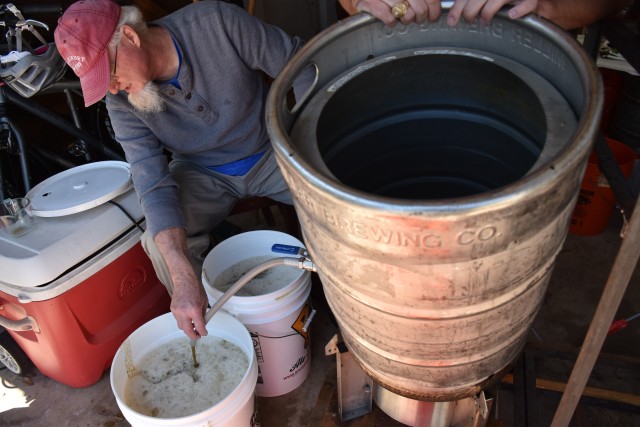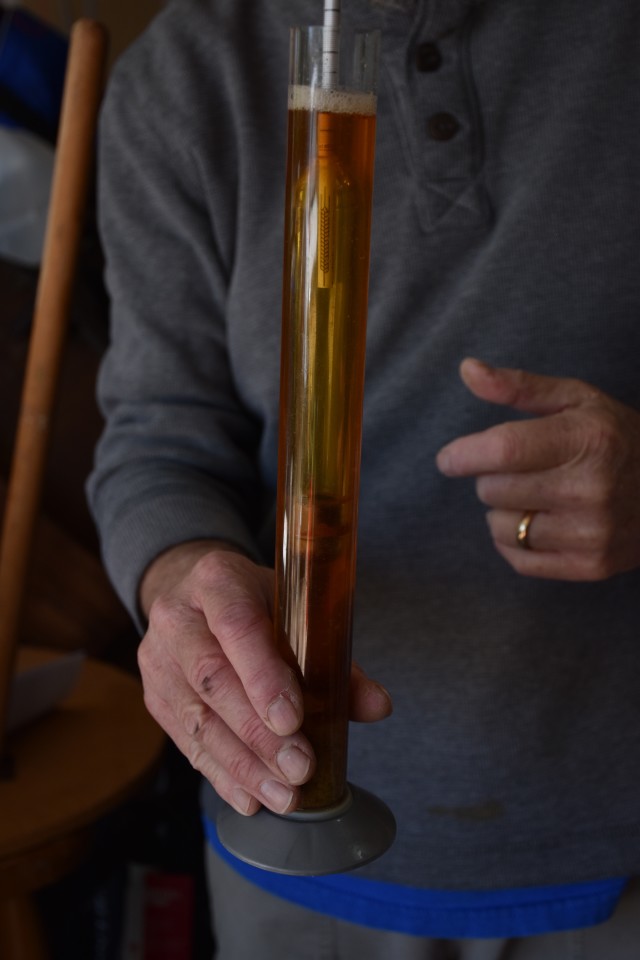Better Than Bud? Home Brewing Is Growing in Austin and Nationwide
By Destinee Reyes
Reporting Texas

Cary Camden transfers cooled wort from the boil kettle to his fermenting bucket. Yeast will be added for fermentation, and the beer will be ready in a couple of weeks. Ye Jin Kim/Reporting Texas
Cary Camden loves to improvise, including with recipes for the beer he brews in his Cedar Park garage.
Last May, in honor of his daughter, who was graduating from Texas A&M University, the software engineer created a special blend and named it for her.
“Her nickname is CC, and she’s blonde, so I made a blond-colored beer and named it CC Blond,” Camden, 62, said. He entered the beer in a competition that summer and won third place.
Camden is among 1.2 million Americans who make beer at home, according to the American Homebrewers Association, based in Boulder, Colorado. The association organizes a national conference, publishes an online magazine and in 1988 designated the first Saturday in May – it’s May 7 this year – as National Homebrew Day, when hobby beer-makers across the country cook up special recipes.
In one measure of the hobby’s growth, sales at brewing supply stores have been growing at double-digit rates in recent years, according to the association’s periodic surveys.
Collectively, home beer makers brew 2 million gallons a year, the association says on its website. Most are relatively new to the hobby: two-thirds began in 2005 or later. More than 2,000 home-brewing clubs are registered with the association, including 11 in metro Austin. Camden belongs to the Texas Carboys, named for a container used in fermentation.
The group has about 50 active members and holds periodic meet-ups, where they share recent home brews or information on how to make better beer, such as using BeerSmith software, which provides recipes, advice and online tools for home brewers.
Local supplier Austin Homebrew Supply is a part of the network for Austin beer makers. The shop in Northwest Austin stocks everything hobbyists need, from equipment to special grains and hops, the essential ingredients.
Mike Smith, 24, a sales associate, said several repeat customers have become friends. One is Jimmy Strassner, who brews only occasionally because of the time commitment. Strassner said that even though it can cost $400 to $500 for the equipment to start brewing, even bad beer he’s made himself is better than store-bought. Strassner, a 55-year-old mechanical engineer, began brewing at home a decade ago, on the recommendation of some friends at work.
Strassner bought the equipment: a hot liquor tank, a boil kettle, a refrigerator to store the beer and a couple of carboys. A 5-gallon batch generally costs around $50 to make – half what he would pay at a store.
Beer-making is not for the impatient. It takes about six hours to start the process, more time a week later if brewers want to do a second fermentation and still more time the following week. Some brewers like to check the temperature of the fermenting beer every other day, just to make sure everything is happening correctly. If the temperature is off, bacteria can grow and ruin the batch.

Cary Camden shows off the color of his wort after measuring its specific gravity. Ye Jin Kim/Reporting Texas
Camden began brewing in 1994 but stopped seven or eight years later, largely because of the time commitment. He started again five years ago when his wife asked him to make her a beer. He now heads to the garage to brew about once a month.
Home brewers are picky drinkers: Camden mainly drinks his own beer or visits one of the Austin area’s growing number of micro-breweries. He won’t touch grocery-store brands, he said.
On a recent Sunday morning, Camden showed friend Thomas Fisher how to brew an all-grain recipe. His garage setup includes a propane tank hooked up to a metal cylinder to heat about eight gallons of “strike water,” the first batch of water that will be used to extract sugars from the grains. Once the water reached 164.9 degrees, Camden poured it into a mash tun – in his case, a 17.5-gallon cooler. Camden then stirred in 26.5 pounds of crushed grain – on this morning, it was mostly a type of barley. The result was a mash that resembles light brown oatmeal with a sweet taste. It steeped for an hour, while the water activated the enzymes in the grain, releasing the sugars. When the wait was up, he moved the sugar water, or wort, into the boil kettle. Soon, Camden began sparging, or adding more boiled water to the mash to rinse away any excess sugars.
After 10 minutes, he mixed the last of the wort into the boil-kettle, measured the specific gravity, or density, of the water to calculate how much sugar was left and let the wort reach a full boil.
Then came the hops, a crucial ingredient that adds aroma and bitterness or citrus flavors. While they boiled in, Camden moved the mash— called “spent grain” after the wort is removed — into buckets to give away as chicken feed. If he has no one to give his spent grain to, he will throw it out, but other uses for spent grain include making bread and dog biscuits.
Once the hops boiled into the wort, he dunked an immersion chiller — coiled copper piping with plastic tubes at each end to allow cold water in and hot water out of the device—into the wort to cool it down and prepare it for fermentation. Camden usually aims to get the liquid to 68 degrees to reduce the risk of bacteria growth.
Camden transferred the cooled wort to the fermenting container — in his case, a 6.5-gallon plastic bucket that can be sealed airtight – and added the yeast. Camden usually lets his beer ferment for two to three weeks before putting it in bottles or kegs. The beer sits for as long as two more weeks before it is ready to drink.
At the end of the morning of instruction, Camden stepped back from the equipment and declared, “And that’s how you make beer.”
Camden said he doesn’t mind the time it takes to brew up a good batch, especially if he can tweak a recipe to make something unique.
“It’s really just the satisfaction of taking grain, water, hops and yeast and making good beer,” he said. “It’s fun.”